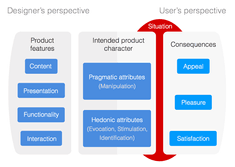How do you feel? Understanding emotions to craft satisfying experiences

Digital platforms and technology allow us to do things quicker and easier. Well, that’s the theory. The reality can often be far from this. How many times have you been looking for information only to give up and visit a competitor site? Unfortunately, badly structured websites and complicated software are all too commonplace. We’ve been spoilt by the likes of Apple and expect this simple, effective and affective user experience across all our interactions with technology.
Customers want experiences “that dazzle their senses, touch their hearts and stimulate their minds” (Schmitt, 1999)
Our relationship with technology affects our emotions and quality of life. Therefore, in order to provide users with positive and satisfying experiences, understanding their emotional responses is a necessity. Experiential marketing assumes that customers take functional features, benefits and quality as a given.
How do we make users like it?
Making users like something is not as easy as you might think. The qualities of physical products, websites, software and other digital media can be classified into two distinct groups (for this we’ll look at the work of Hassenzahl et al. 2000):
1. Pragmatic qualities
Pragmatic qualities relate to practicality and functionality.
– Manipulation
Manipulation refers to the functionality and how that functionality is accessed, i.e. the usability. At a very basic level, can it do what it needs to do? A consequence of pragmatic qualities is satisfaction. Satisfaction occurs when a user uses a product or service to achieve certain goals and those goals are met.
Examples of attributes that are typically assigned to websites (and software in general) are “supporting,” “useful,” “clear” and “controllable.” The purpose should be clear and the user should understand how to use it.
2. Hedonic qualities
Hedonic qualities refer to the psychological needs and emotional experience of the user.
Hedonic qualities are divided into three categories:
– Stimulation
Users want to be stimulated in order to enjoy their experience with your site, software or product. Rarely used functions can stimulate the user and satisfy the human urge for personal development and more skills. Digital experiences can provide insights and surprises, for example, if after a period of time a feature hasn’t yet been used, the software could inform the user via a quick tip.
– Identification
The human need for expressing ourselves through objects to control how you want to be perceived by others. We all have a desire to communicate our identity to others and we do this through the things we own and the things we use. They help us to express ourselves; who we are, what we care about and who we aspire to be. This is why people enjoy using personalisation on sites such as Twitter. Changing our background wallpaper and header image, helps us to express ourselves.
– Evocation
Which memories and feelings does the experience evoke?
Evocation refers to the symbolic meanings that the experience has on our memories and our background. The visual aesthetics of a website may remind you of a past experience. For example, a travel website with a background image of a beach, might bring back memories of a past holiday and all the feelings (most likely highly positive) associated with that experience. As we all have different experiences in our lives, what we feel when we look at an identical website will be unique to us, the individual.
It is the combined pragmatic and hedonic aspects that form the appeal and the amount of appeal that a digital or physical platform has.
Situation
The users’ experience also depends on the context of use. Where are they? What do they need to do? How many times have they used it? Who are they with? How much time do they have to do what they need to do?
The first time a user tries an application, they may experience some confusion and minor issues, leaving with a slightly negative experience. However, when they become more familiar with all the features and how to access them, they will become more emotionally attached to it, and therefore each use becomes a pleasant user experience. This can be problematic within User Experience design as a poor, inefficient interface may be disliked by it’s users but they can be reluctant to change it because they have learnt how to use it. Therefore their perceived effort to deal with the change and the additional learning is deemed greater than sticking with the poorly designed current system.
Which feelings are felt with a good user experience?
The most satisfying user experiences are related to positive emotions such as, enthusiasm, pride, interest and inspiration. These positive emotional responses are all related to the hedonic qualities of the product: for example enthusiasm is connected to the stimulation dimension and pride is related to the identification quality. The hedonic qualities of interactions are those that make us feel an experience is satisfying.
In contrast, users who feel irritated, hostile and upset experience more pragmatic (usability) and technical problems.
Emotions and user experience: a recent study
Recent research by Tampere University in Finland (Partala & Kallinen) about the emotional aspects of users’ experience highlights how the most satisfying experiences are related to positive emotions, those that fulfil our psychological needs and are more personal to us.
Our sense of time changes with pleasurable experiences
When people enjoy the most satisfying user experiences, such as playing Angry Birds, they typically report feeling not especially hurried and people often lose track of time. In psychology we refer to this as entering a state of ‘flow’. However, when an experience is frustrating and unsatisfying, a moderate level of urgency is felt and time may appear to go slower.
Satisfying experience and psychological needs
Users that have a satisfying digital experience will report emotions connected to the fulfilment of the most important psychological needs:
Autonomy “I make my own choices and decisions”
Competence “I can do this”
Self–esteem “This makes me feel good about myself”
Relatedness “This is connected to my needs”
As supported in the psychological theory of Self Determination (Deci & Ryan, 2000), the fulfilment of these needs emphasises psychological growth, integrity and wellbeing. An individual’s experience of autonomy, competence, and relatedness is argued to foster the most high quality forms of motivation and engagement for activities, including enhanced performance, persistence, and creativity. So if you want to create engagement or you want to motivate your users, perhaps to change their current behaviour or habits, then you should look to how you can utilise psychological needs.
Understand users and exceed expectations
Nowadays, users are not only looking for efficiency and good usability. What makes the user experience unique and enjoyable is making people feel confident, stimulated and surprised. Connect with your users on an emotional level.
Observing behaviour, analysing and asking users to reflect on their own experiences through user research offers the opportunity to design experiences that satisfy the user’s true needs, leaving them with an experience that exceeds expectations, creates long term engagement, increases brand value and ‘wows!’. People will then use your website or app not because they have to but because they want to.
You might also like:
Share this post:

